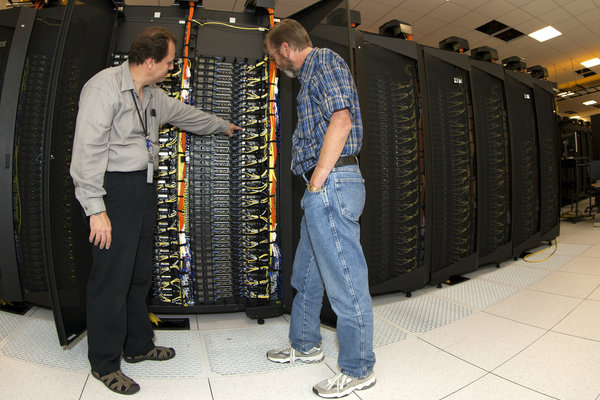Director of operations and services at NCAR’s Computational and Information Systems Lab, Anke Kamrath told Atmos News, “Whether it’s the threat of solar storms or a heightened risk in certain severe weather events, this new system will help lead to improved predictions and strengthen society’s resilience to potential disasters.”
Cheyenne will replace Yellowstone, shown below, the NWSC’s prior computer that is no longer quite as super. The visualizations in the video above were created using Yellowstone, and similar work will be done on Cheyenne. NCAR picked Yellowstone out back in 2011 and made it available for use in summer 2012. Since then, more than 2,200 researchers from over 300 federal labs and universities have used NWSC and Yellowstone for research.
Yellowstone ran on Intel Sandy Bridge EP processors in an IBM iDataPlex system and was rated for 1.6 petaflops. Cheyenne will run on Intel Broadwell processors for a 5.34-petaflop rating – 5.34 quadrillion calculations a second. NCAR plans to integrate Cheyenne with the GLADE file system already in use.
“Cheyenne will be a key component of the research infrastructure of the United States through its provision of supercomputing specially tailored for the atmospheric, geospace, and related sciences.” NCAR direction James Hurrell said. The new supercomputer will help improve predictions across a range of fronts, including decadal prediction (ten-year climate models) and 11-year solar cycle timing to determine its possible impacts on tech like GPS.
Cheyenne is set for installation this year, and will be ready for operation in 2017. David Hosansky, Head of Media Relations at NCAR told us, “Allocations on the supercomputer go through a national committee process.” Said process may not have begun for Cheyenne yet, so if you’re thinking NWSC might help your future research, keep an eye on the University Corporation for Atmospheric Research’s website.
Editors' Recommendations
- This new VR headset beats the Vision Pro in one key way and is half the price
- Samsung’s new OLED gaming monitor might have a problem
- Dell’s new UltraSharp monitors have one major innovation
- Corsair’s new standing desk might finally tempt me to buy one
- This new gaming laptop might have water cooling and an RTX 4090



